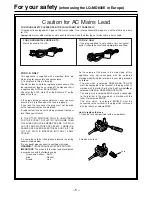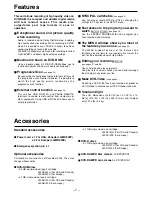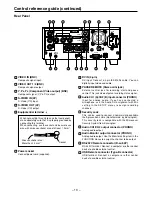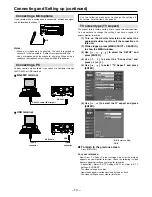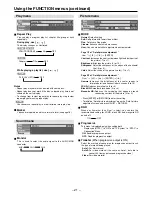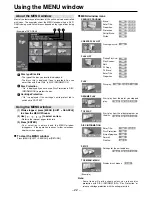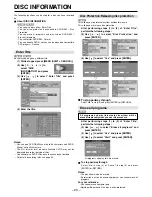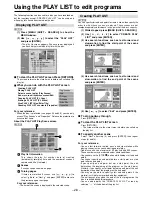
– 13 –
Connecting and Setting up (continued)
COMPONENT VIDEO OUT terminal
These terminals can be used for either interlace or progressive
output and provide a purer picture than the S-VIDEO OUT
terminal.
Connection using these terminals outputs the color difference
signals (P
B
/P
R
) and luminance signal (Y) separately in order to
achieve high fidelity in reproducing colors.
• The description of the component video input terminals
depends on the monitor television (e.g., Y/P
B
/P
R
, Y/B-Y/R-Y,
Y/C
B
/C
R
).
To watch progressive video (NTSC only)
Connect to the component video (480P) input terminals on a
monitor television compatible with this unit's copy guard system.
(Video will not be displayed correctly if connected to an
incompatible monitor television.)
• All Panasonic monitor televisions that have 480P input
terminals are compatible. Consult the manufacturer if you have
another brand of monitor television.
Regarding Progressive Television Picture
Progressive image aspect (height to width ratio) is set at a
standard 16:9. DVD-Video which has been set at 16:9 will be
displayed correctly. However, 4:3 video material will be
stretched to the right and left when displayed.
To view the picture at the right aspect
• For monitor televisions that allow the aspect of progressive
images to be adjusted, use the function provided on the
monitor television and adjust as necessary.
• For monitor televisions which do not allow the aspect of
progressive images to be adjusted, please set “Progressive
(NTSC)” to “Off”.
Note:
• If the unit is connected to the TV through VIDEO OUT or S-
VIDEO OUT, output signal will be interlace only (even if you
select progressive output).
DV terminal
DV cable (4P-4P or 4P-6P)
AC mains lead (supplied)
Notes:
• Be sure to observe the following points when connecting the
IEEE1394 cable (DV cable).
· This unit and all connected equipment should be used with a shared
GND connection. If all equipment is not connected to a shared GND,
turn off the power to all equipment before connecting or removing the
IEEE1394 cable.
· When connecting to equipment having a 6-pin terminal, connect the
IEEE1394 cable to the 6-pin terminal first and then to the terminal on
this unit.
· When connecting to equipment having a 6-pin terminal, be sure to
connect the end of the IEEE1394 cable that matches the terminal
shape. Inserting the wrong end of the plug can damage the unit.
• The DV input on this unit is for use with DV equipment only.
• When DV equipment is connected, it is not possible to operate
the unit from the other equipment.
• Only one piece of DV equipment (e.g., Digital Video Camera)
can be connected to the unit via the DV Input terminal.
• The picture compression system of the DV equipment you have
connected may differ from that used in this unit. In such cases,
dubbing from this equipment will not be possible.
S-Video, stereo audio terminals
S-Video cable (4P)
Stereo Audio cable (PHONO x 2)
AC mains lead (supplied)
Composite video, stereo audio terminals
Video cable (BNC)
Stereo Audio cable (PHONO x 2)
AC mains lead (supplied)
Connecting a video player
VIDEO
VIDEO
S-VIDEO
S-VIDEO
1
2
Y
CH1(A)
DV IN
RS-232C
USB
~ AC IN
PAUSE
REMOTE
CH2(B)
CH1
CH2
PB
PR
VIDEO IN
VIDEO OUT
AUDIO IN
AUDIO OUT
AUDIO
MON
VIDEO
VIDEO
S-VIDEO
S-VIDEO
1
2
Y
CH1(A)
DV IN
RS-232C
USB
~ AC IN
PAUSE
REMOTE
CH2(B)
CH1
CH2
PB
PR
VIDEO IN
VIDEO OUT
AUDIO IN
AUDIO OUT
AUDIO
MON
VIDEO
VIDEO
S-VIDEO
S-VIDEO
1
2
Y
CH1(A)
DV IN
RS-232C
USB
~ AC IN
PAUSE
REMOTE
CH2(B)
CH1
CH2
PB
PR
VIDEO IN
VIDEO OUT
AUDIO IN
AUDIO OUT
AUDIO
MON
DV IN
DV OUT
VIDEO
IN
VIDEO
OUT
S-VIDEO
IN
S-VIDEO
OUT
Video player
Video player
Video player
AUDIO IN
AUDIO
OUT
AUDIO
OUT
AUDIO IN





